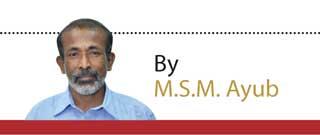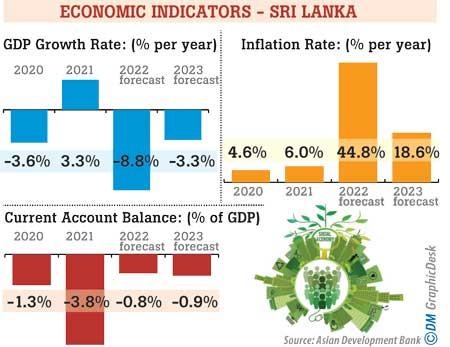01 Oct 2022 - {{hitsCtrl.values.hits}}
The gazette notification is further interesting as the new High Security Zones have been declared at a time when there is no threat to those areas declared HSZs
If the police or the armed forces could take legal action against those protesters under normal laws, one would wonder whether those areas need to be declared as HSZs
 It is interesting to note President Ranil Wickremesinghe has issued a gazette notification on September 23 declaring several High Security Zones (HSZs) in Colombo and suburbs under the Official Secrets Act of 1955. The legality of the gazette has to be decided by a court of law, but it is amusing to hear HSZs having been established under the Official Secrets Act.
It is interesting to note President Ranil Wickremesinghe has issued a gazette notification on September 23 declaring several High Security Zones (HSZs) in Colombo and suburbs under the Official Secrets Act of 1955. The legality of the gazette has to be decided by a court of law, but it is amusing to hear HSZs having been established under the Official Secrets Act.
The Human Rights Commission of Sri Lanka (HRCSL) has also said in a statement on September 26 that the declaration of HSZs under the Official Secrets Act is “a fallacy without any justification and basis.” The HRCSL has also said that the declaration grossly violates the fundamental rights of the people. It called on the government to withdraw the declaration and take measures to ensure that national laws are following accepted international and national human rights norms and standards.
 The gazette notification is further interesting as the new High Security Zones have been declared at a time when there is no threat to those areas declared HSZs. One might argue that since the offices and official residences of the President and the Prime Minister had been forcibly occupied and the Parliament was about to be occupied in July by thousands of protesters, the government has been compelled to declare such areas as HSZs.
The gazette notification is further interesting as the new High Security Zones have been declared at a time when there is no threat to those areas declared HSZs. One might argue that since the offices and official residences of the President and the Prime Minister had been forcibly occupied and the Parliament was about to be occupied in July by thousands of protesters, the government has been compelled to declare such areas as HSZs.
However, one cannot forget that security forces very easily clamped down on those protesters as they were by and large peaceful except for a few excesses. Also, the crackdown on the protesters was unleashed without the relevant areas being declared as HSZs.
Even a child knows that occupying government or private premises or damaging properties in them is unlawful and those who commit such offences can be brought to book under normal law. Already police have arrested and produced before courts at least a few hundred persons out of hundreds of thousands of people who barged into the offices and the official residences of the President and the Prime Minister on July 9. If the police or the armed forces could take legal action against those protesters under normal laws, one would wonder whether those areas need to be declared as HSZs.
Nevertheless, it was later reported that the government is reconsidering its decision apparently realizing the threat of the decision being annulled by the judiciary. The Samagi Jana Balawegaya (SJB) has already filed a fundamental rights petition before the Supreme Court on September 28 and the Bar Association of Sri Lanka (BASL) had also stated that it would legally challenge the President’s decision.
The surrounding areas of the Parliament, Police Headquarters, offices and the official residences of the President, Prime Minister, Defence Secretary and heads of armed forces are the latest HSZs. When going through the gazette it is very clear that it was the recent public uprising or the Aragalaya that prompted the government to declare these areas as HSZs. According to the gazette no person is allowed to conduct or hold public gatherings and processions within the HSZs in Colombo and the suburbs without permission from the police.
The move indicates that the economic crisis that has engulfed the country now is to worsen in the coming months and the government seems to expect more agitations by the people. It is also an indication of the government’s lack of confidence over its plans, especially the programme involving the International Monetary Fund (IMF) to resolve the economic hardships faced by the people.
In fact, despite the people seeming to hope their sufferings to end with the successful implementation of the IMF programme out of desperation, nobody is assured of what is really in store for the country when the programme is implemented. Though the government has come to a staff-level agreement with the IMF, it hesitates to reveal the details of it, in spite of several requests by the Opposition political parties. This has confused the people and gives sufficient room for those political parties who are against any dealings with the IMF to further confuse them.
It has been revealed recently that the IMF is to grant a loan of 2.9 billion dollars to Sri Lanka for a period of four years under the staff-level agreement which has to be approved by the international lender’s management board. This is a meagre amount compared with over 3 billion dollars granted as loans by India within this year alone. Sri Lanka needs around 6 billion dollars a year to import fuel and the foreign debt payment due was about 4 billion dollars when the authorities decided to suspend the debt payments in April, in order to prevent a hard default.
Therefore, it is clear that it is the debt restructuring and macroeconomic plans that the government has to prepare with IMF support that would really matter if anything fruitful is to happen. The road ahead is still not clear in respect of debt restructuring owing to China’s stand on the matter and how the government is going to resolve the balance of payment issue is also yet to be revealed. And with the emphasis given by the government on cracking down possible protests, by way of the declaration of high security zones, one has to expect the socioeconomic issues to deteriorate further in the near future.
The United National Party (UNP) which was viewed by many as a party with repressive policies during the governments led by former Presidents J.R. Jayewardene and Ranasinghe Premadasa created a liberal image of it among the international community under its current leader Ranil Wickremesinghe. He first opted for peace instead of war when dealing with the Liberation Tigers of Tamil Eelam (LTTE) and supported the Norwegian mediation in resolving the ethnic issue in the country during the tail end of President Chandrika Kumaratunga’s tenure. Then the UNP’s peacemaker image further grew with the peace talks between the government and the LTTE in 2002, with the involvement of many powerful countries such as the US, UK, Japan and India.
Wickremesinghe’s next government in 2015 again gained further acclaim from the international community as it followed a conciliatory approach towards the United Nations Human Rights Council (UNHRC), in contrast to the previous Mahinda Rajapaksa regime. His government co-sponsored the resolution on Sri Lanka adopted by the council in March 2015.
However, the party’s liberal image which was built for two decades has been fast eroding since July. The government invited condemnation from the international community when the armed forces attacked the protesters who had occupied the offices and official residences of the President and the Prime Minister in the early hours of July 22, despite them having announced that they would leave the premises in the afternoon on the same day. The decision on HSZs will further harm the party’s image locally as well as internationally, while people are at a loss to know whom to blame, UNP or the ruling SLPP or both.
10 Jan 2025 20 minute ago
10 Jan 2025 2 hours ago
10 Jan 2025 3 hours ago
10 Jan 2025 4 hours ago
10 Jan 2025 4 hours ago